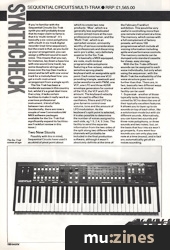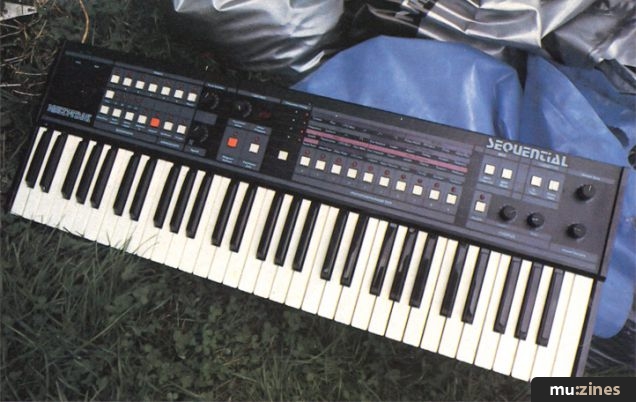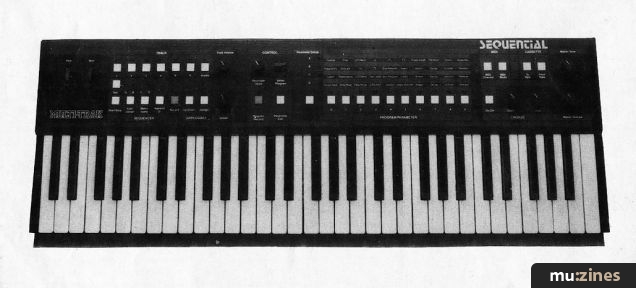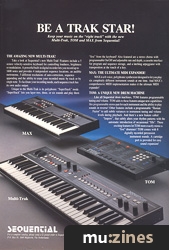Magazine Archive
Home -> Magazines -> Issues -> Articles in this issue -> View
SCI Multi-Trak | |
SynthcheckArticle from International Musician & Recording World, April 1985 | |
The professional successor to the Six-Trak meets Curtis Schwartz

The Six-Trak comes of age
If you're familiar with the Sequential Circuits Six-Trak synth you will probably know that its major claim to fame is that it is 'multi timbral': it's basically a six-voice polyphonic with a built-in six-track digital recorder (real-time sequencer), but the crack is that, as you build up your arrangement, you can assign a different sound to each voice. This means that you can, for instance, lay down a bass line with one sound (one track), lay some duophonic strings and brass over the top (two tracks a piece) and be left with one voice/track for a melody/lead line: you get a multi instrument arrangement from a single synth.
The Six-Trak has been a moderate success in this country but, whilst it's a great deal more than a toy, it lacks certain facilities to make it really work as a serious professional instrument; it kind of falls between two stools. (Incidentally, there are now a couple of new Commodore 64/MIDI software packages available for the Six-Trak that significantly expand its facilities — see Frankfurt review in this issue.)
Two New Stools
Possibly with this in mind. Sequential Circuits have used it as a kind of pivot point about which to create two new products: 'Max', which is a generally less sophisticated version aimed more at the non-professional consumer, and the 'Multi-Trak', which is an upmarket version, eminently worthy of serious consideration by professionals and discerning semi-pro's alike; very definitely superior to the Six-Trak.
It's basically a MIDI equipped, six-note, multi-timbral programmable polyphonic featuring a five-octave, velocity-sensitive sprung plastic keyboard with an assignable split point. Each voice has one VCO providing triangle, sawtooth and pulse waveforms with PWM, one VCF, one LFO and three ADSR envelope generators for control of the VCA, the VCF and LFO amount. The keyboard velocity can be used to effect the oscillators, filters and LFO's to give dynamic control over volume, tone and the amount of LFO modulation. As the keyboard's split point is selected, it is also possible to determine the number of voices assigned to each side, eg 1:5, 2:4, 3:3 etc. The facility to send the separate information from the two sides of the split along two different MIDI channels will probably be included in the final production software, although it wasn't absolutely definite at the time of the February Frankfurt exhibition. This would be very useful in controlling more than one remote instrument at a time. The memory, which comes with a full complement of factory presets, will store 100 programmes which include all voicing information including splits and performance controls. The memory contents can be dumped onto standard cassette for cheap, easy storage.
With the Six-Trak different sounds can be assigned to each voice individually, but only when using the sequencer; with the Multi-Trak the malleability of the voice structure goes much further than that. There are, in fact, basically two different ways in which this multi-timbral facility can be used:
1: Superstak — another of those typically tacky American terms, coined by SCI to describe one of their typically excellent features. It allows you to layer up to six sounds on top of each other, like a solo/unison mode but with six different sounds. Alternatively, you can have two sounds and three-note polyphony, or three sounds and two notes; but, on the basis that four into six won't go properly, if you want four sounds you can only play one note at a time (mono), and in fact you automatically get all six voices sounding.
2. Ensemble — this is more or less like an extended, expanded version of the original Six-Trak multi-sound, multitrack recording, using the on-board sequencer. The Multi-Trak has a 1600 note capacity (as opposed to the Six-Trak's 700), it stores key velocity information and has a wide range of editing facilities. The 1600 notes are split up into four sections (A, B, C, D) which, once recorded, can be chained together in any order (eg C, A, A, D, C, B etc) to create a longer piece. Any of these sections can be 'truncated', ie you can chop its end off from any point, and also any individual note or track can be erased. Although it is possible in this way to 'drop-out' individual notes, it isn't possible to drop them on; if you make a mistake and need to replace or insert a note, you gotta go back to square one, or if you just can't face playing it all again, you could truncate the sequence from your mistake, record the remainder correctly into another section and chain it onto the end.

Headers
At the beginning of each of the sections within a chained sequence there is a set of instructions termed 'the header' in which information regarding relative track volumes and timbres is stored. These values can be changed at anytime as part of the edit facilities, but a more sophisticated and useful feature is that of being able to alter the contents of a header, even for the same section, each time it appears at different points throughout the chained piece. In this way you can have the same section occur any number of times, with a different arrangement in each case, and so the effective number of sections you have to play with is greatly expanded. Damned ingenious!
Like the Six-Trak, the MultiTrack has a built-in metronome to keep you on course, but unlike its lesser brother it also has five degrees of auto-correction. Often, the most difficult lines to get in time are the slow ones, so if you're playing a very simple, unsyncopated line, you can have it corrected to the nearest fraction of a beat as selected, thereby ensuring that nobody laughs at you for being incompetent. Alternatively, if you're laying down sometin' a little more serious, it will give you a totally free hand, or ever correct to triplets for an instant Jazz feel. The speed of the sequencer can be synced via the MIDI port or via an external 24Hz pulse.
An excellent feature is that of having a choice of either using six separate outputs, one for each track/voice, or stereo outputs to make use of the built-in chorus — which I'll mention later. This makes it ideal for either live or multitrack studio work.
If you don't use up all the voices with the sequence, the remainder can be used for playing live over the top of it, once again using any voice desired.
One of the least satisfying features of the Six-Trak was the quality of its preset sounds; it seemed that, being a single oscillator arrangement, even the famous SCI filter technology couldn't pull them out of the 'nice but gutless' category. But that would all appear to be history as there is now a whole new set of voicings available, applicable to all three synths in this series, that sound very good. We're talking punchier brass, stringier strings, gutsier bass and thicker, sweeping lead lines, and a built-in chorus with adjustable depth and rate that lends the usual warmth and spatiality to anything it's applied to. There are also some very convincing drum and percussion sounds, so that your sequences can include a full backline, if desired. My only real experience of these sounds is through the Multi-Trak, and so it may be that the touch sensitivity has a lot to do with the subjective power of the voicings, but even so they're a vast improvement and can be easily fed into any existing Six-Trak.
There is also an in-built arpeggiator capable of arpeggiating in all relevant directions or in the order in which you depress the key. It is also latchable by means of a front panel switch or a footswitch, and once set running it can be transposed at the touch of a button, making it far more musically useful than the Six Trak fixed pitch version. While this is going on you are free to use the remaining five voices to play along with it (key changes won't affect the real time playing).
MIDI Mode Numbers
Just when you thought you'd finally got the hang of the MIDI mode terminology, or maybe you'd just signed yourself to a stage of passive ignorance, the current mode names — Omni, Poly and Mono, are soon to be know as modes one, three and four respectively. Mode two is exclusive to Yamaha, and configures all voices of all synths in any serial system to play in unison ie the same note. It's a kind of alternative interpretation of Mono Mode, and will only work between correctly configured Yamaha synths. The Multi-Trak will work in all three of the standard modes, including mode four which allows individual access to each voice.
Editing is still via a centralised digital access system, but again it's a great improvement on the Six-Trak. The 40 main variables are laid out in a 4 x 10 matrix with each position marked by an LED. A set of nudge buttons allows quick selection of the desired parameter, and then it's back to the centralised incrementor to change the setting. The same two digit display provides details of all current values in both the play and edit modes.
If the Six-Trak was a little disappointing, the Multi-Trak totally renews my faith in SCI innovation. It's a winner.
SEQUENTIAL CIRCUITS MULTI-TRAK — RRP: £1,565.00
Also featuring gear in this article
Sequential Multi-Trak
(12T Jun 85)
Trak-Fakts - Sequential Multi-Trak
(ES May 85)
Browse category: Synthesizer > Sequential Circuits
Publisher: International Musician & Recording World - Cover Publications Ltd, Northern & Shell Ltd.
The current copyright owner/s of this content may differ from the originally published copyright notice.
More details on copyright ownership...
Review by Jim Betteridge
Previous article in this issue:
Next article in this issue:
Help Support The Things You Love
mu:zines is the result of thousands of hours of effort, and will require many thousands more going forward to reach our goals of getting all this content online.
If you value this resource, you can support this project - it really helps!
Donations for May 2024
Issues donated this month: 0
New issues that have been donated or scanned for us this month.
Funds donated this month: £0.00
All donations and support are gratefully appreciated - thank you.
Magazines Needed - Can You Help?
Do you have any of these magazine issues?
If so, and you can donate, lend or scan them to help complete our archive, please get in touch via the Contribute page - thanks!








